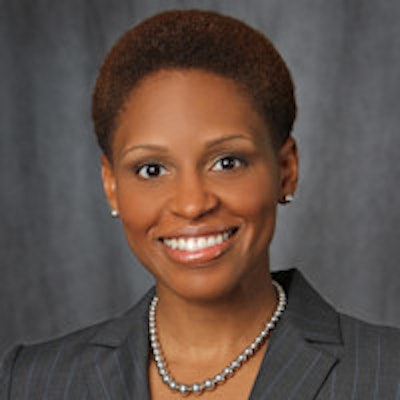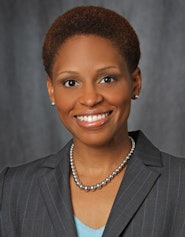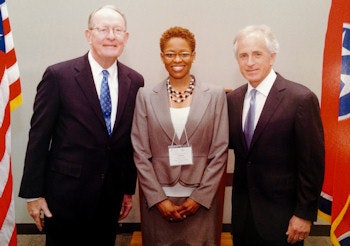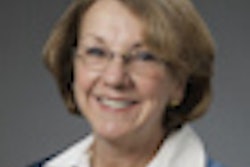
Tawana Lee Ware, DDS, has traveled just about every path in dentistry: public health, private practice, and now academia. As the new president of the American Association of Women Dentists (AAWD), Dr. Ware would like to see more women in leadership roles in dentistry and the development of dental armamentarium that is ergonomically designed for the anatomy of women dentists.
Dr. Ware's latest incarnation as AAWD's president is just the latest role in a remarkably varied career.
"Dentistry is a wonderfully diverse and flexible career path," she told DrBicuspid.com. "My life shows you can own your own business and be an entrepreneur in private practice or work in public health. Now I'm teaching. It just shows the diversity of the path; if you become a dentist, you don't have to just do one thing."
 Tawana Lee Ware, DDS, president of AAWD.
Tawana Lee Ware, DDS, president of AAWD.As a professor at the Meharry Medical College School of Dentistry in Nashville, TN, Dr. Ware draws upon her varied background to give her students a sense of the range of opportunities that dentistry offers.
"I tell my students that you have to be diverse in your skill set," she explained. "Students are very curious about life in the real world."
After graduating from Meharry, Dr. Ware dreamed of getting a doctorate in public health at Harvard. But during her stint as a National Health Service Corps dental scholar, she was impressed by the work of pediatric dentists at a Native American reservation.
"I was knee-deep in pediatric dentistry," Dr. Ware recalled. "It was really an amazing experience working with pediatric dentists in that environment. It kind of planted a seed there."
Then, her mentor at Meharry, Sharon Carter, DDS, helped her realize how much she enjoyed working with children. "As a healthcare scholar in pediatric dentistry, you really are a public advocate. I never thought of it that way before, and she was right," Dr. Ware said.
She was able to "give back" by working in a community health center, in private practice participating in the Give Kids A Smile program, and in her missionary work in Guatemala and Jamaica.
"I just always had that passion for public health and children," Dr. Ware said. "You gather all these experiences."
Her current research includes the oral health disparities among children, and she has coauthored several studies on the problem.
Affordable Care Act
Dr. Ware is hopeful that the Patient Protection and Affordable Care Act's mandate for pediatric dental care will increase access to care, especially for poor children.
"It will provide insurance coverage for many children and extend the safety net," she said. "So many children don't have dental care, and their parents can't afford it, particularly the working poor."
 AAWD President Dr. Tawana Lee Ware and U.S. Sens. Lamar Alexander and Bob Corker of Tennessee on Advocacy Day for the American Dental Education Association and the American Association for Dental Research in Washington, DC. Image courtesy of Dr. Ware.
AAWD President Dr. Tawana Lee Ware and U.S. Sens. Lamar Alexander and Bob Corker of Tennessee on Advocacy Day for the American Dental Education Association and the American Association for Dental Research in Washington, DC. Image courtesy of Dr. Ware.She noted that studies show 20% of children have 80% of the caries reported for the group. "I'm hoping that utilization of care will increase as well as access, but we're going to have to do some education and make parents aware this is available."
Dr. Ware added, "Are there enough pediatric dentists to see all these children? No, not enough to meet needs. But you don't have to be a pediatric dentist to treat children."
Making it easier for dentists to navigate the Medicaid system and increasing reimbursements from federal and state programs would help children get more dental care, she noted.
"Wouldn't it be wonderful if dentists could document the services they donate and get tax breaks?" she suggested. "We have to rally together as a profession and come up with creative solutions that we can advocate in Washington."
Midlevel providers
Regarding the controversial issue of authorizing midlevel providers (MLPs), which many state are considering, Dr. Ware doesn't think MLPs provide the sole solution to access-to-care barriers.
She pointed out that supplies and overhead cost the same for MLPs as dentists.
"Unless they're going to be mandated to work in rural areas where the greatest need is, if you look at the economics, I don't think one thing will be a panacea or magic pill," Dr. Ware explained. "I think it's a multifaceted problem. I don't think we've worked out all the challenges with the workforce we currently have."
During an educational exchange trip to Southern Africa with the American Academy of Pediatric Dentistry, she noted that poor people go to MLPs for care while the rich go to private practitioners. Most countries that have MLPs have socialized medicine, Dr. Ware pointed out.
Juggling personal/professional life
As a full-time teacher, wife, and mother of a 3-year-old girl, and now facing a busy schedule as AAWD president, Dr. Ware has "lots of late nights and early mornings."
"There's a lot of day planners and balancing calendars and keeping things organized with my husband (a chiropractor). I'm a bible-toting, Sheryl Sandberg fan," Dr. Ware said, referring to the author of Lean In: Women, Work, and the Will to Lead, Facebook's chief operating officer, and advocate of women's leadership. "One way I'm able to get this big life of mine in order is because I'm definitely supported and leaning in with a husband who's a full partner who jumps in there and helps a lot."
Her divergent paths and experiences helped forge her role as a teacher, which Dr. Ware relishes.
"I call myself the king maker because I already know what it's like to be king -- I've been in private practice, now I get to indoctrinate and train more dentists," she said. "My students ask about career/life balance, having a family, becoming an associate, going into private practice, about my experience as a clinician scholar," she said. "They ask about working in public health because they have a lot of debt."
As an African-American woman dentist and AAWD president, Dr. Ware is mindful that she serves as a role model.
"My mom always said excellence is the great equalizer," she recalled. "I am an African-American female so I do fit into those categories. But I hope I can reach other women who look like me and people, in general, to strive for their dreams and put forth their best effort. But I definitely identify and recognize that I am a mentor, and I try to live my life with that responsibility in mind."
Issues facing women dentists
More than 50,000 women dentists are now practicing in the U.S., and women make up about half of the current dental students.
A 2014 survey of AAWD's members showed that women dentists strive for work/life balance. They also felt there are now more barriers to starting their practices. Some 56% of members own their own practice, and 17% recently retired or sold their practice.
And sexism continues: Some 75% of members said they have been mistaken for dental staff by industry representatives.
Dr. Ware noted that dental armamentarium (handpieces, extraction forceps, doctor's stools, etc.) ergonomically designed for the anatomy of women dentists is a key area of growth for dental manufacturers. The AAWD survey showed that 70% of women dentists make the purchasing decisions for their practices.
"Equipment is designed for male dentists," she explained. "Women are smaller in stature. I'm 5 feet 4 inches, and sometimes I have difficulty sitting in a dental chair and getting into a comfortable position with patients."
Dr. Ware would also like to see more women in leadership positions in the dental profession and industry.
"When you look at the [ADA] House of Delegates, there are not a lot of women," she said. Also, there aren't many women deans of dental schools, Dr. Ware pointed out. "It's difficult for women to get into the pipeline for leadership positions."
Still, she thinks dentistry offers great career opportunities for women. "In private practice, you can soar, you can soar in academia, you can soar in public health. There are even women in corporate positions in the dental industry," Dr. Ware said. "You find your path and figure out how to make it work. I feel like I'm in my bliss moment right now; I feel like I'm thriving. I learn something new every day with students. I just get the ultimate joy of knowing that I'm having a hand in shaping the future with my students. It's great."



















